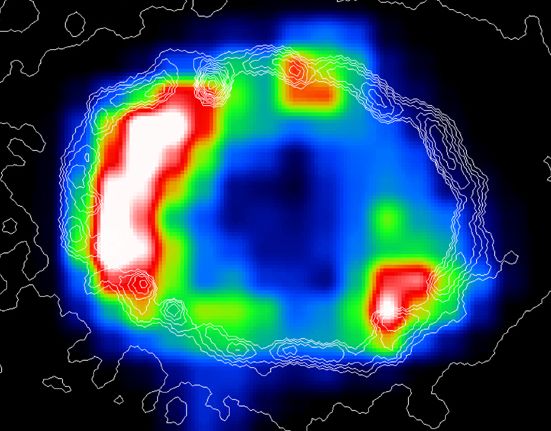Explanation: This false-color image from the Chandra X-ray Observatory reveals a one light-year diameter ring of hot, ten million degree plasma. It is one of the most detailed X-ray images of the expanding blast wave from supernova 1987A (SN1987A). At visible wavelengths SN1987A is famous for its evolving rings, and superposed on this image are white contour lines which outline the innermost optical ring as seen by the Hubble Space Telescope. The composite picture clearly shows that the X-ray emitting shocked material lies just inside the optical ring. In fact, the X-ray emission seems to peak (whitest color) close to where the optical emission peaks (closely spaced contours), a persuasive demonstration that the optical light is produced as the blast wave plows into surrounding material. What will SN1987A look like in the future? According to a popular model, in coming years the expanding supernova blast wave should hit and light up even more material while the violent impacts send reverse shocks back towards the site of the explosion and light up the ejected stellar debris. In any event, astronomers will watch eagerly from a ringside seat as a new supernova remnant emerges.
1999 2000 2001 2002 2003 2004 2005 2006 2007 2008 2009 2010 2011 2012 2013 2014 2015 2016 2017 2018 2019 2020 2021 2022 2023 2024 2025 |
Yanvar' Fevral' Mart Aprel' Mai Iyun' Iyul' Avgust Sentyabr' Oktyabr' Noyabr' Dekabr' |
NASA Web Site Statements, Warnings, and Disclaimers
NASA Official: Jay Norris. Specific rights apply.
A service of: LHEA at NASA / GSFC
& Michigan Tech. U.
|
Publikacii s klyuchevymi slovami:
SN 1987a - shock - supernova remnant - ring - Sverhnovye - vzryvy sverhnovyh - ostatok Sverhnovoi
Publikacii so slovami: SN 1987a - shock - supernova remnant - ring - Sverhnovye - vzryvy sverhnovyh - ostatok Sverhnovoi | |
Sm. takzhe:
Vse publikacii na tu zhe temu >> | |
